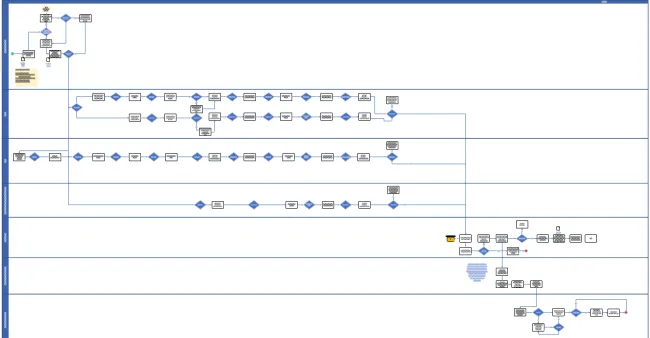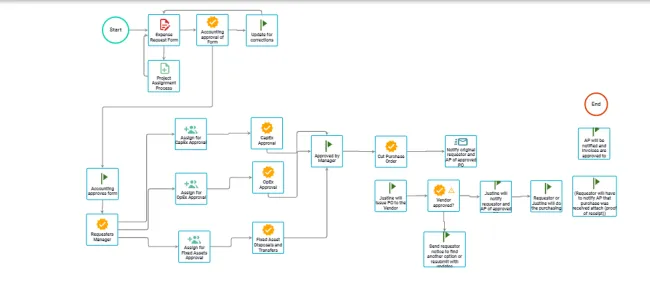Caregility streamlines processes and enhances compliance
Table of contents

The Caregility(opens in a new tab) platform spans inpatient and outpatient telemedicine settings, with clinical workflow integrations and secure, reliable two-way audio and video communication. From within major EMRs and telecommunication protocols such as SIP, family members, interpreters, and outside clinicians can be added to virtual visits or patient observation with a click. The software is compatible with all major mobile and computing devices used in clinical, subacute care, and home environments, with 24/7, secure, HIPAA-compliant access.
The Challenge
While transferring from a startup to a more full-force enterprise, Caregility needed to standardize its processes to remain competitive in the healthcare market. A major challenge was some unknowns on where breakdowns and bottlenecks were happening in the processes.
Another challenge that needed to be addressed was the lack of process documentation. “Most of the tribal knowledge lived in our stakeholder's heads, and getting that on paper was difficult,” according to Kareem Ayad, an independent contractor at Caregility assigned to the project.
If one of these stakeholders were to leave the company, they would bring that knowledge with them; then, there was no way to get that information since it was not documented anywhere.
Given these challenges, Caregility needed Nutrient Workflow to:
- Document its processes to continue the best practices with new stakeholders.
- Build a blueprint for running its internal and external affairs.
- Find bottlenecks in current processes.
- Standardize existing and planned processes.
Why Nutrient Workflow?
“The functions and features that were demonstrated to the team made it an easy choice,” said Kareem.
“Nutrient Workflow is very user-friendly with the drag-and-drop process building, and its easy and intuitive form designer helps us navigate quickly to certain process steps with built-in dynamic assigners. Even without IT knowledge, since it is a drag-and-drop environment, it is easy for the process builders to start building quickly."
A feature that stuck out to Caregility was that Nutrient Workflow offers workflow solutions categorized by industry, making it easier to match platform presets to their specific needs. Kareem and his team needed a secure platform prioritizing compliance in the healthcare industry.
Another significant benefit of the Nutrient Workflow platform that stuck out to Caregility was its ability to ensure processes and procedures meet the standards set by their organization or department. Every organization has unique processes and requests, so having standards set by each department for different processes allowed all needs to be met throughout the organization.
Implementation
After going forward with Nutrient Workflow, users were excited to begin building and documenting their processes. Caregility could quickly visualize workflows in a new way during implementation because of the no-code, drag-and-drop environment. Then, once workflows were laid out, Kareem and his team began noticing a disconnect between what should be happening vs. what was happening.
Ayad explained, “We identified waste areas and tons of manual steps causing reoccurring errors or inaccurate approvals for certain spending.”
Also, during the implementation and building of their workflows, Caregility was impressed by how easy it was to configure and build business rules in their processes. Then, using the Nutrient Workflow tasks and rules strengthened the ability to provide team members with standard operating procedures they can follow to ensure process fidelity. The approval feature and routing in Nutrient Workflow showed Caregility how easy it is to submit, route, review, approve and track different document types.
During the implementation stage, the doors opened for Caregility to see just how much was possible. Caregility now had complete visibility and the ability to manage its processes like never before. Toward the end of the roll out, stakeholders agreed that the platform made processes more efficient and easier to manage.
What They've Built
Caregility has about 15 workflows in progress and another 6 in the queue. Some of the workflows that have been built so far are:
- A budget process was used as a training process as they began building out new processes.
- A Procure to Pay process for our stakeholders and accounting team.
- A project assignment form and process for the Accounts Payable teams.
- A process called “Stage Gate” is a product management workflow of how they review new products and projects.
By having the visual representation while using Nutrient Workflow’s process builder, Caregility could reduce loopholes and redundancies and ensure the proper execution of future state processes once they begin rolling out more processes.
Another process that Caregility has built that we’d like to highlight is their “Produce to Pay” process. Below are two images, one of them being the process built out how it was handled before Nutrient Workflow – which had about 40 steps. But they could heavily condense these older processes into a much simpler version thanks to automation.
Old version:
Automated process with Nutrient Workflow:
Results
Since Caregility is just beginning to exit the testing and QA phases of rollout, the quantifiable results still need to be captured.
"We have seen user errors and cycle times for each process go down drastically compared to our manual past processes before Nutrient Workflow.”
What's Next?
Nutrient Workflow is rolled out throughout the enterprise, mainly focused on the Accounting and Sales divisions. Next, they plan on expanding Nutrient Workflow into the IT and HR departments, and they have another 5-6 processes in the queue lined up for next quarter.









